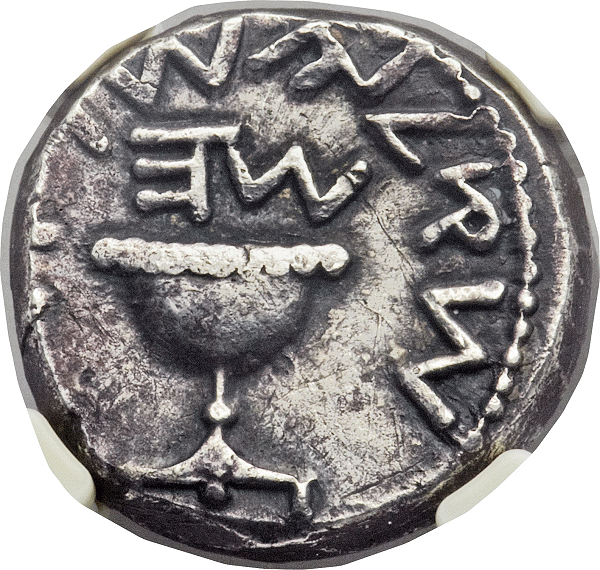By Lorie Ann Hambly for Heritage Auctions ……
One of the most important coins in this year’s Platinum Night offering is also one of the most humble-looking pieces: The famous Hunt-Shoshana Year 5 Shekel of the Jewish War against Rome (66-70 CE). This silver piece, about the diameter of a modern quarter but much thicker and heavier, contains a vast amount of history within its battered silver surfaces.

Its creation came in the climactic fifth year of an enormous conflict that started in the Roman province of Judea and quickly spread to engulf the whole Roman world. Kingdoms crashed, dynasties collapsed, and hundreds of thousands of people died in this five-year cataclysm. Even after the dust finally settled, the world would never be the same. Remarkably, Heritage’s auction has shekels from all five years of the conflict! The story of the Great Jewish War, and the empire-wide War Of The Five Emperors it triggered, is too long and convoluted to relay in the space of this article (the best account remains The Jewish War by the turncoat rebel Flavius Josephus, who personally witnessed the entire conflict), but the “bullet points” alone are monumental enough:
Year 1 (66):
Decades of abuse heaped on the people of Judea by their Roman occupiers finally ignites a full-scale rebellion. The rebels attack and expel the Roman garrison of Jerusalem; when Legion XII Fulminata marches from Syria into Judea in response, it is completely annihilated. After a spasm of internecine warfare (the rebels were of many factions united only in their hatred of Rome), the pro-Roman King Agrippa II flees his province, and the Temple authorities in Jerusalem declare a free and independent Israel. A mint is set up in the temple and the first shekel coins are struck, following Mosaic tradition in omitting any “graven image” and depicting a ceremonial chalice (sometimes identified as the ritual “omer cup”) on the obverse, and a sprig of three pomegranates (likely the top of a ceremonial staff) on the reverse. The Hebrew legends proclaim “Shekel of Israel” and “Jerusalem the Holy,” and the obverse bears a date: Year 1 of the new regime.
Year 2 (66/7):
The Roman regime of Nero cannot allow Judaea to break away, else the whole Imperial edifice comes crashing down. Nero responds by assembling a huge task force of four Legions and placing it under the command of a capable general of humble origins, Vespasian. The invasion commences early in 67 CE and finds the Jews have reinforced Jerusalem in expectation of his attack. Instead, Vespasian re-occupies the countryside and reduces rebel strongholds one by one, isolating the capital city. The fortified town of Yodfat, commanded by a certain Yosef ben Matitiyahu, falls after a 45-day siege; Yosef (Josephus) abruptly switches sides and wins Vespasian’s trust by boldly predicting he will become Emperor of Rome, a seemingly laughable prophecy given the general’s low birth. Vespasian’s patient strategy results in hundreds of thousands of Jews fleeing to Jerusalem for shelter, overtaxing the rebel regime’s resources and causing a new round of internal strife between the Zealots and other factions. Meanwhile in Rome…
Year 3 (67/8):
While Vespasian slowly grinds down the rebellion and the Jews war amongst themselves, the regime of Nero abruptly collapses and the Roman Empire becomes a playing pitch for rival generals. Abandoned by all, Nero commits suicide in May of 68; Galba, governor of Spain, replaces him, but within months…
Year 4(68/9):
…Galba is murdered by the playboy pretender Otho, who immediately faces another revolt by Vitellius, governor of Upper Germany. Armies march, battles blaze, and the whole Roman world descends into chaos. Amid it all, it occurs to Vespasian that in this “game of thrones,” the ridiculous prophecy of Josephus might actually come true! He hands over the Judaean campaign to his son, the brave and capable Titus, and assembles an army to make his own bid for supreme power. Titus, whose lover is the Jewish princess Berenice, sister of Agrippa II, scales back operations in support of his father’s bid for the throne, correctly figuring the Jewish rebels will continue to slaughter each other and make his ultimate job easier.
Year 5 (69/70):
While Vespasian’s forces wage civil war in the West, Titus decides to roll the dice and risk all on a strike at the center of the rebellion, Jerusalem.
In December 69 CE, Vespasian wins his bid and is the last contender standing in Rome as the year closes. Early in 70 CE, Titus undertakes a titanic siege of Jerusalem, which drags on for seven months while the Jews within the city’s massive walls suffer unspeakable hardships and inflict horrific atrocities on one another. During this time, the last Year 5 silver shekels of the Jewish regime are struck, finding their way in the pouches of a handful of rebels who manage to break the siege lines and escape to Masada, the mountaintop fortress originally built by King Herod. Jerusalem falls in stages, the outer city in May of 70, and the temple complex finally in July. Tens of thousands of Jews are crucified and executed in other unpleasant ways; hundreds of thousands are sold into slavery. Titus returns to Rome and a rapturous welcome in 71; Masada manages to hold out until early 73 CE, when 960 rebels and their families commit ritual suicide rather than be taken alive by the Romans. Among these was one person who held, and hid, a silver shekel of Year 5, which was found by someone residing in a new, free Israel, 20 centuries later.
Thus, and deservedly, the year 5 shekel ranks as likely the most storied coin in the Judaean series. Only about a dozen “regular” shekels such as the Hunt-Shoshana specimen survive today to inspire anyone with a love of history, and freedom.
Jewish War Shekels Currently Available on eBay
[wpebayads]




